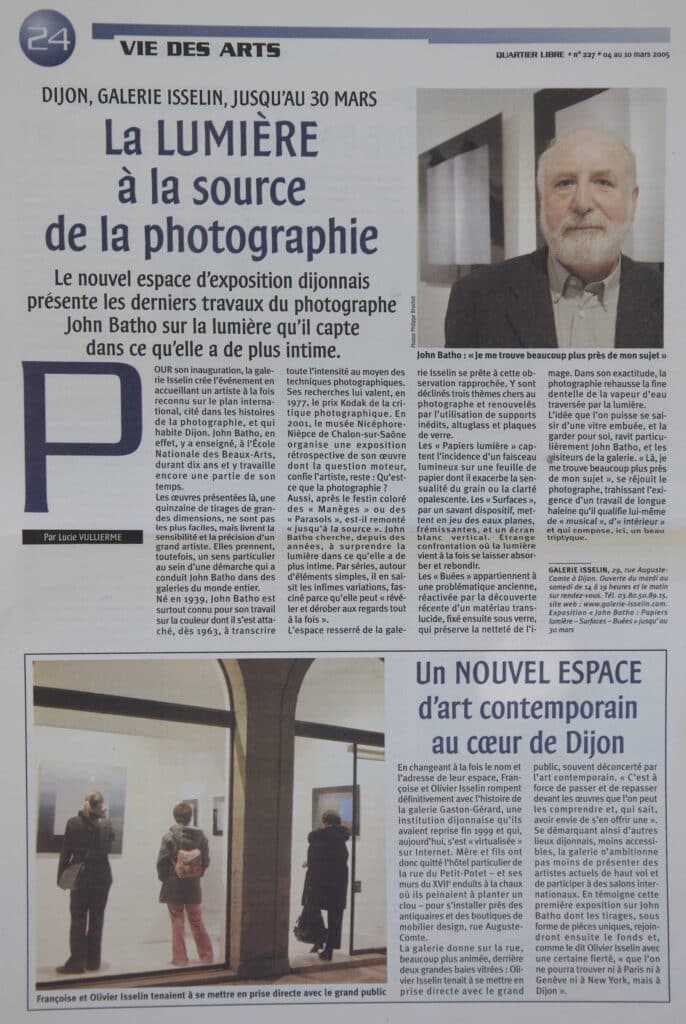+ A New Contemporary Art Space in the Heart of Dijon.
Articles – by Lucie Vuillerme – Le Bien Public – Quartier Libre Weekly Supplement – Life of the Arts Section – March 4th to 10th, 2005 – Issue No. 227, p. 24.

The new exhibition space in Dijon presents the latest works of photographer John Batho, focusing on the intimate essence of the light he captures.
For its inauguration, the Isselin gallery creates a stir by hosting an artist who is internationally recognized, mentioned in the history of photography, and who resides in Dijon. John Batho, indeed, taught there at the School of Fine Arts for ten years and still works there part of the time.
The works presented, about fifteen large-format prints, are not the easiest, but they reveal the sensitivity and precision of a great artist. However, they take on a particular meaning within a trajectory that has led John Batho to galleries worldwide.
Born in 1939, John Batho is best known for his work on color, in which he has been dedicated since 1963 to capturing its full intensity through photographic techniques. His research earned him the Kodak Award for Photographic Criticism in 1977. In 2001, the Nicéphore Niépce Museum in Chalon-sur-Saône organized a retrospective of his work, and the artist confides that the driving question behind it all remains: What is photography?
Also, after the colorful feast of “Manèges” (carousels) or “Parasols” (parasols), he went back “to the source”. For years, John Batho has been seeking to capture the most intimate aspects of light. Through series focused on simple elements, he captures its subtle variations, fascinated by its ability to “reveal and conceal at the same time”.
The intimate space of the Isselin gallery lends itself to this close observation. Three themes dear to the photographer are explored, each renewed through the use of unique materials: altuglass and glass plates.
The “Papiers Lumière” (light papers) capture the impact of a beam of light on a sheet of paper, intensifying the sensuality of its texture or opalescent clarity. The “Surfaces” feature a skillful arrangement that involves still, shimmering water and a vertical white screen. It creates a strange confrontation where light both absorbs and bounces off the surfaces.
The “Buées” (mists) belong to an ancient issue that has been revived by the recent discovery of a translucent material, which is then fixed under glass to preserve image sharpness. Through photography’s precision, the delicate lacework of light-penetrated water vapor is enhanced. The idea of capturing and preserving a fogged-up window delights John Batho and the gallery visitors. “There, I am much closer to my subject,” rejoices the photographer, betraying the demanding nature of his long-term, self-described “musical” and “introspective” work, which composes a beautiful triptych in this exhibition.
A NEW contemporary art space in the heart of Dijon.
By changing both the name and the address of their space, Françoise and Olivier Isselin definitively break away from the history of Galerie Gaston-Gérard, a Dijon institution that they took over at the end of 1999, which has now “virtualized” itself on the internet. Mother and son have left the private mansion on Rue du Petit-Potet, with its 17th-century lime-coated walls where they struggled to hang a nail, to settle near antique shops and designer furniture boutiques on Rue Auguste Comte.
The art gallery faces the street, which is much livelier, behind two large glass windows: Olivier Isselin insisted on having direct interaction with the general public, who often feel bewildered by contemporary art. “It is by repeatedly passing by and looking at artworks that one can understand them and, who knows, even feel compelled to acquire one.” Setting themselves apart from other less accessible locations in Dijon, the gallery aims to present top-notch contemporary artists and participate in international exhibitions. This is evidenced by their first exhibition featuring John Batho, whose unique prints will later become part of the gallery’s collection. As Olivier Isselin proudly states, “They won’t be found in Paris, Geneva, or New York, but in Dijon.”





